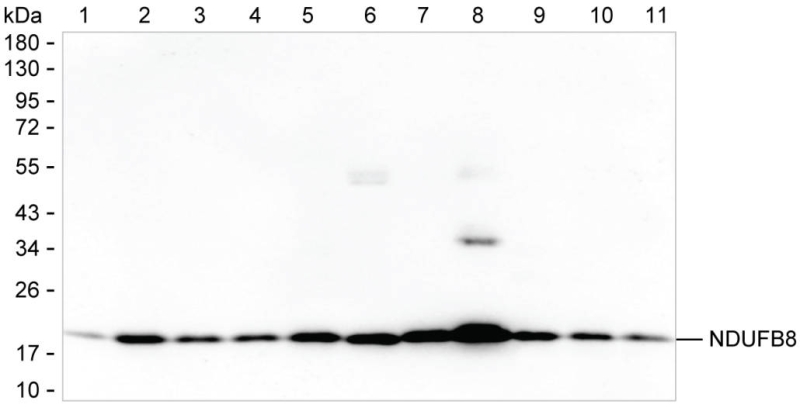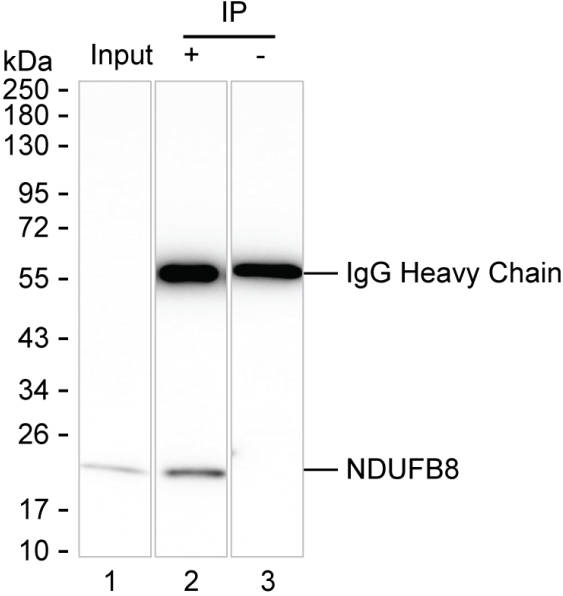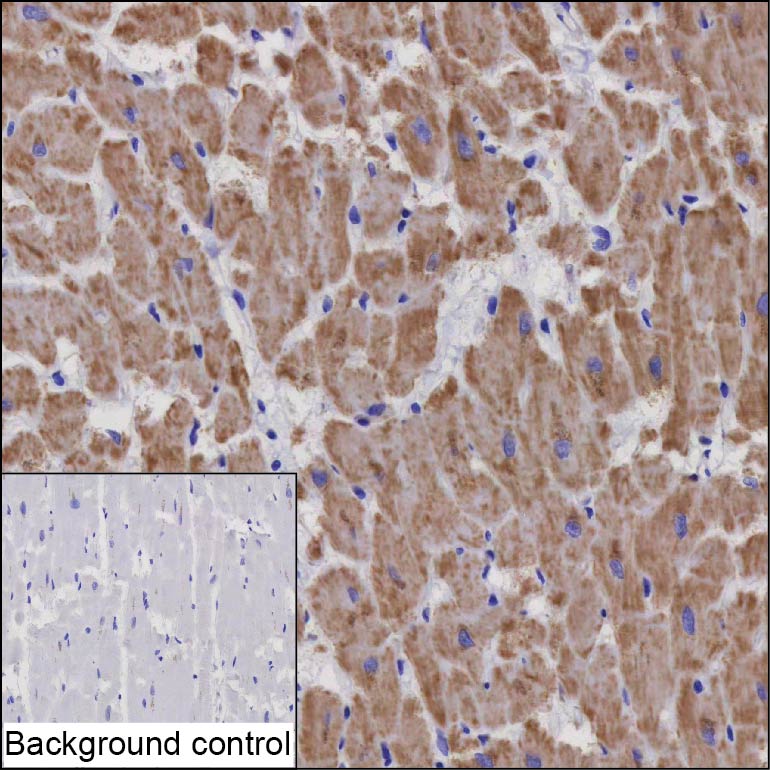


| WB | 咨询技术 | Human, Rat, Mouse |
| IF | 1/100-1/200 | Human, Rat, Mouse |
| IHC | 1/25-1/200 | Human, Rat, Mouse |
| ICC | 技术咨询 | Human, Rat, Mouse |
| FCM | 咨询技术 | Human, Rat, Mouse |
| Elisa | 咨询技术 | Human, Rat, Mouse |
| Host/Isotype | Mouse IgG1 |
| Antibody Type | Primary antibody |
| Storage | Store at 4°C short term. Aliquot and store at -20°C long term. Avoid freeze/thaw cycles. |
| Species Reactivity | Human, Rat, Mouse |
| Immunogen | Purified recombinant fragment of human NDUFB8 |
| Formulation | Purified antibody in PBS with 0.05% sodium azide |
+ +
以下是3篇关于NDUFB8抗体的参考文献及其摘要概括:
---
1. **文献名称**: *"NDUFB8 mutations cause mitochondrial complex I deficiency in individuals with Leigh-like encephalomyopathy"*
**作者**: Calvo SE, et al.
**摘要**: 该研究通过全外显子测序发现NDUFB8基因突变导致线粒体复合物I功能障碍,利用NDUFB8抗体进行蛋白质印迹分析,证实患者细胞中复合物I亚基表达显著降低,揭示了其在Leigh综合征相关脑肌病中的作用。
---
2. **文献名称**: *"Assessment of mitochondrial respiratory chain complex assembly and function in cultured cells using NDUFB8 antibody"*
**作者**: Ghezzi D, et al.
**摘要**: 研究提出一种基于NDUFB8抗体的蛋白质印迹方法,用于快速评估线粒体复合物I的组装状态。通过比较正常与病理模型(如帕金森病细胞),发现NDUFB8表达水平与复合物I活性呈正相关,为诊断线粒体疾病提供工具。
---
3. **文献名称**: *"Antibody-based profiling of mitochondrial complex I defects in cancer cell lines"*
**作者**: López-Ríos F, et al.
**摘要**: 研究利用NDUFB8抗体对多种癌细胞系中线粒体复合物I的表达进行检测,发现部分癌细胞中NDUFB8蛋白表达缺失与化疗耐药性相关,提示其作为癌症治疗靶点的潜力。
---
以上文献均以NDUFB8抗体为核心实验工具,聚焦于线粒体功能、疾病机制或诊断技术的研究。
NDUFB8 antibody targets the NDUFB8 protein, a crucial subunit of mitochondrial Complex I (NADH:ubiquinone oxidoreductase) in the electron transport chain. Complex I, the largest respiratory complex, facilitates NADH oxidation and proton translocation, essential for ATP synthesis. NDUFB8. encoded by the nuclear *NDUFB8* gene, is one of 45 subunits composing Complex I, playing a structural and functional role in its assembly and catalytic activity. Antibodies against NDUFB8 are widely used to study Complex I expression, stability, and mitochondrial dysfunction.
NDUFB8 antibodies are critical tools in research on mitochondrial disorders (e.g., Leigh syndrome), neurodegenerative diseases (e.g., Parkinson’s), and cancer, where Complex I deficiencies or mutations are implicated. They enable detection of NDUFB8 via Western blotting, immunofluorescence, or immunohistochemistry, helping assess protein levels in tissues, cell lines, or animal models. Specificity is validated using knockdown/knockout controls, confirming the absence of cross-reactivity with other subunits.
Commercial NDUFB8 antibodies are typically raised in rabbits or mice using synthetic peptides or recombinant proteins. Researchers prioritize antibodies validated for multiple applications and species reactivity (human, mouse, rat). Proper validation ensures accurate interpretation of mitochondrial health and disease mechanisms. As mitochondrial research expands, NDUFB8 antibodies remain indispensable for elucidating metabolic reprogramming, oxidative stress responses, and therapeutic interventions targeting cellular energy pathways.
×